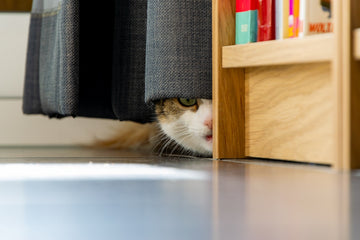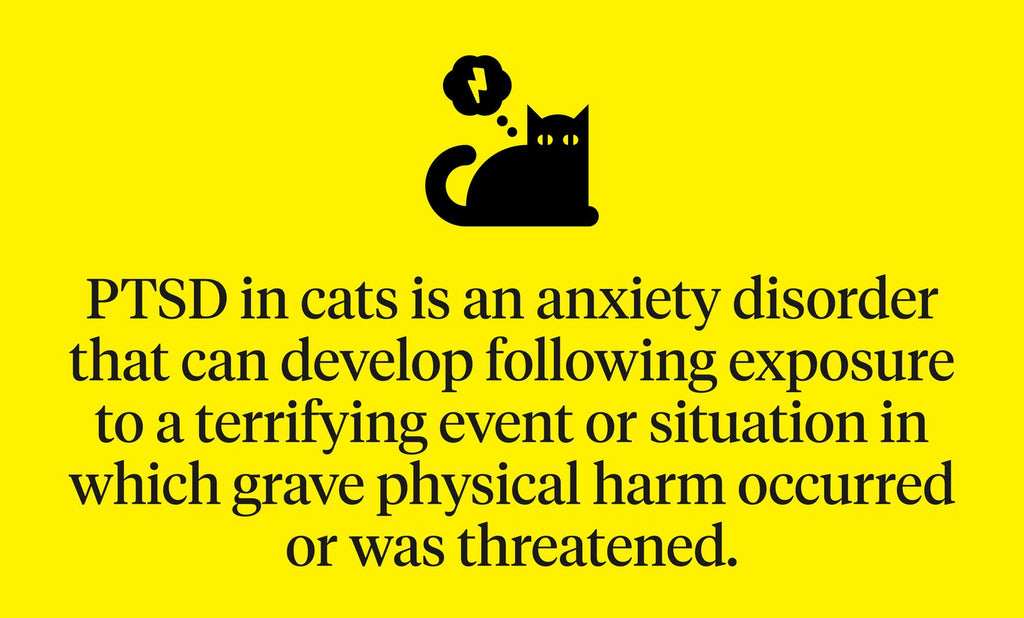7 Min Read
Traumatized Cat: Signs To Look For
Key takeaway

Why pet owners are switching to online vet care with Dutch
-
Prescriptions delivered free to you
-
Fast access to Licensed Vets over video
-
Unlimited video visits and follow-ups
There's a chance your cat could have post-traumatic stress disorder (PTSD) if they have experienced one or more traumatic instances throughout their lives. Cats with PTSD can exhibit unusual changes in behavior as well as significant distress related to their disorder. The distress caused by trauma can cause changes in your cat's diet, urination, and other normal activities.
It's important to spot the signs of PTSD in your cat early on so that you can provide some relief for their symptoms and help them live happier, healthier lives.
- What Is Post Traumatic Stress Disorder (PTSD) In Cats?
- Traumatized Cat Symptoms
- Treating A Cat With Symptoms Of Trauma
- Traumatized Cat Symptoms: Frequently Asked Questions
- Final Notes
What Is Post Traumatic Stress Disorder (PTSD) In Cats?
PTSD in cats is an anxiety disorder that can develop following exposure to a terrifying event or situation in which grave physical harm occurred or was threatened. This disorder can cause cats to change their behaviors drastically. Cats with PTSD also might live with a significant amount of distress until they find suitable medicine and treatment. Not all cats that go through these terrifying types of experiences will develop PTSD, but for those that do, finding an effective treatment can greatly improve their quality of life.

Traumatized Cat Symptoms
In order to help your cat, it’s important to watch for signs of trauma. PTSD can manifest in a variety of behavioral symptoms; some of these behavioral changes can lead to other health complications if this trauma is not attended to.
Understanding your cat’s regular behavior and routines and keeping an eye out for irregularities is usually the first step in diagnosing PTSD. It’s important to record changes in your cat’s behavior for your veterinarian so they can gain a better understanding of your cat's personality and better pinpoint the reasons for your cat’s behavior, along with appropriate treatment.
If you’re concerned your cat may be suffering from PTSD, keep an eye out for these symptoms:
-
Uncharacteristic aggressiveness
If your cat has gone through a harrowing experience, they might feel like they need to be on the defensive all the time in order to be safe. If you find that your cat is particularly aggressive, clawing, scratching, pawing or biting, this is an important note to discuss with your vet since it may be a sign of PTSD. You might also find that your cat has heightened aggression in certain situations, such as when you have guests over or there’s loud construction at the neighbor’s house.
-
Fearfulness, trembling, shaking
Another symptom of PTSD and a distressed cat is fearfulness observed through shaking and trembling. PTSD can cause your cat to live in fear of external threats and they may tremble or shake especially in stressful situations. Cat anxiety and constant fear may also lead to different cat skin conditions and health issues, so it’s essential that you find appropriate treatment as soon as possible.These symptoms may be a sign of another underlying health condition which is why it's important to seek immediate veterinary care if you find your cat is shaking.
-
Decreased appetite and weight loss
If your cat has PTSD, they might also exhibit abnormal eating patterns or refuse to eat at all, resulting in extreme and unhealthy weight loss. If your cat won’t eat or eats very little, seek advice from your vet. They may suggest dietary changes to help ensure your cat receives the nutrition he or she needs.
-
Reduced interest in playing or interacting with other pets, people or both
Some cats exhibit low energy when they are feeling under the weather or have an underlying health condition. Your cat might also show less interest in playing or interacting with you or other pets if they are suffering from post-traumatic stress disorder. Motivation and drive is often exhibited through play, so if your cat is not interested in playing, it might be because they're feeling too stressed out to focus on anything else.
-
Hypervigilance
For some of the same reasons your cat might be overly aggressive, your cat might also show signs of hypervigilance because they're always on the lookout trying to avoid the next threat following a terrifying incident. Hypervigilance is often demonstrated by sensitivity to movement, changes in your cat's environment, or sound.
-
Urinating or defecating inappropriately
When cats are anxious or stressed they might also have trouble managing their bladders and may urinate, spray, or defecate irregularly. Urinating problems related to PTSD might include straining when urinating and eliminating in abnormal places.

-
Increased neediness or attachment
Well it can be cute sometimes, if you find that your cat is showing increased neediness or vocalization towards you it might be because they're feeling scared or anxious. Taking note of when your cat seems needier than other times might help you figure out if there's some sort of external stimuli that is stressing them out. This information can also be helpful when your vet is trying to diagnose a health issue.
-
Excessive meowing
Another sign that your cat is feeling anxious is increased vocalization. This can come in the form of meowing or yowling and is sometimes a sign of distress.
-
Destruction
When your cat is feeling really stressed or anxious, they might end up taking it out on your furniture, and causing destruction around the house. Destructive tendencies are sometimes used as a way for your cat to release pent-up energy.
-
Sleep disturbances
PTSD can also impact your cat's sleep patterns and make it tough for them to get deep rest. If you find that your cat is waking up often, is causing disturbances in the night that are outside their normal behavior, this might also be a sign of fear or stress.
-
Pacing
Pacing and hyperactivity often go hand-in-hand with hypervigilance, and these symptoms might mean your cat is feeling defensive and panicked. Your cat might not be able to relax, and will roam around, pacing your house; this behavior can be a tell that they are feeling anxious and are in need of some relief.
-
Hiding / Avoidance of things, places, or people associated with traumatic event
One of the most obvious signs that your cat is afraid of a certain stimulus is if they try hard to hide or avoid that person, place or situation. Maybe your cat does everything they can to avoid a bath or they might cower when they are around other animals; this can be a signal that they've had a bad experience with that stimuli in the past.
Treating A Cat With Symptoms Of Trauma
Only a licensed veterinarian or veterinary behaviorist can diagnose PTSD in cats. With your vet’s guidance, you may find success in treating signs of feline trauma with the following methods:
- Management changes to their environment
- Counterconditioning
- Desensitization
- Medication
Your cat’s trauma may be best treated through the use of pharmaceuticals. It’s important to ask your vet or veterinary behaviorist to diagnose your cat before starting a course of medical treatment. The most common form of treatment for cats with PTSD is aimed at desensitizing the cat from a given stimulus.
Traumatized Cat Symptoms: Frequently Asked Questions
How do I know if my cat is traumatized?
If you find your cat exhibiting abnormal behavior, and notice marked changes in their eating habits, sleeping habits, or affection or aggression towards you, this might be a sign of PTSD in your cat.
What happens when a cat is traumatized?
When your cat goes through a terrifying situation or event, it might cause them to become fearful of internal or external stimuli that triggers a memory of that event or situation. Because they're always on the lookout, they exhibit certain behavioral symptoms linked to their previous trauma.
Can a cat recover from trauma?
Absolutely. With the right veterinary treatment and a plan that centers around counterconditioning and desensitization, you can help improve your cat’s quality of life.

Final Notes
It can be heartbreaking to watch your cat experience distress, and for many pet owners, it can be difficult to determine why cats are exhibiting symptoms of PTSD. Our team is here to help you find the right answers when you feel like your cat might be showing signs of anxiety, stress and PTSD.
There are an array of treatment options for your feline family member, including medication. Dutch.com is a great way to have your cat evaluated quickly and if advised, get the medication they need to feel at ease. With Dutch, you can connect with licensed veterinarians online who can help you determine the best treatment plan for your cat.
Share
References
-
Behavioral Problems of Cats, Merck Vet Manual, https://www.merckvetmanual.com/behavior/normal-social-behavior-and-behavioral-problems-of-domestic-animals/behavioral-problems-of-cats
-
Domschke, Katharina, and Eduard Maron. “Genetic factors in anxiety disorders.” Modern trends in pharmacopsychiatry vol. 29 (2013): 24-46. doi:10.1159/000351932
-
Treatment of Behavior Problems in Cats, Merck Veterinary Manual, https://www.merckvetmanual.com/cat-owners/behavior-of-cats/treatment-of-behavior-problems-in-cats
-
Behavioral awareness in the feline consultation: Understanding physical and emotional health.
Debra F Horwitz, Ilona Rodan, April 30, 2018, Journal of Feline Medicine and Surgery, https://journals.sagepub.com/eprint/tQt3ueaFug2WEPpwqppX/full




